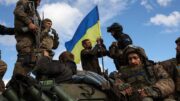In February 2022, under orders from President Vladimir Putin, Russian forces launched an invasion of Ukrainian territory. This event has continued to affect millions across the nation, especially in the populous Northern capital city, Kyiv, and the Eastern half of the country, as longitudinally bisected by the Dnipro River.
Although the war shows little sign of ending soon, the novelty of the situation has faded and it appears people want to consider more local matters. Public interest in the ongoing war continues to decline on social media and in response to a lack of demand for this information, only brief and grim reminders of the destruction now appear in the mainstream media. So, what have you missed these past few months in the European struggle?
Events by the Numbers
By early September, Ukraine forces had nearly reclaimed all of the northeastern lands, cutting off the undersupplied Russians’ supply lines in the southeast. They continued to make headway before reaching a temporary standstill (in terms of acquiring or losing territory) in October. Fighting continues in only a few cities including Marinka, Avdiivka, and Soledar.
Since the beginning of offenses into Ukraine, losses on both sides stand at forty thousand dead, fifty-three thousand non-fatally injured, fifteen thousand missing, fourteen million displaced, 140,000 buildings destroyed, and $350 billion dollars of property damage. Both involved parties, seemingly in an attempt to display confidence, have estimated their opponents’ killed and wounded to sum to just under 100,000 whilst considering their own losses minimal at little more than 10,000. The United States claims that the former figures are the most likely scenario, with neither side much better off than the other in terms of these casualties at about 100,000 each. The Russian-supporting People’s Republics of Donetsk and Luhansk have each suffered fewer than 5,000 losses.
As for refugees, the top ten host countries currently accommodate around four million Ukrainians and still more account for some three million others. Poland currently bears 1.5 million refugees as the most popular destination for escape. Many that have been forced to Russia endure torture and execution. One-third of all Ukrainians have been displaced by the war, and 13 million more are stranded in the country because of fighting, impassable routes, or lack of resources to move.
The weather has not been kind to either party as of late. Conditions have developed such that every day is cold, yet the ground remains wet and thus, difficult to advance in. Power failures have swept the country, and while most homes have a restored water supply, only 90% have heating and a mere three-fourths have electricity.
Inside Politics
The first Russian invasion of Ukraine was back in 2014, which has effectively continued since then. Aggression remained dormant for several years as trading pressure was applied in the Kerch Strait, conflict droned on in Crimea and Donbas’ trench warfare, and little territory changed hands. Through tactics that included propaganda, economic pressure, and cyber attacks, Vladimir Putin urged the pursuance of Ukrainian subduction. The only recent change is that Russia has revitalized its forces through much larger commitments than it has applied until now, supposedly intending to destroy Ukraine as an independent state under the guise of the “demilitarization” and “denazification” of Ukraine. This may change under the command of new Russian General Sergei Surovikin as new operations are planned and executed, yet there is reason to believe that Russia will continue to seek quick and decisive victories, even under this new leadership.
The approval ratings of the Ukrainian president, Volodimir Zelensky, surged after the beginning of the war as patriotism coursed through the veins of inspired underdogs. In recent months, however, weary survivors are less confident in his capabilities, though positivity in his efforts remains far higher than before the war. He has offered in many interviews how he feels he isn’t doing enough and feels nothing but guilt for allowing the situation to reach this state. He finds it increasingly difficult to maintain amiable negotiations with any party at this point.
Elon Musk remains in the public eye for his decision to retract free Starlink service to Ukraine due to unprofessional remarks from Ukrainian diplomat Andrij Melnyk after Musk offered unsolicited advice on how to end the war. The proposed solution would supposedly increase Russia’s foothold in Eurasia, and President Volodymyr Zelenskyy, in response to the suggestion, began questioning Musk’s allegiances. Starlink is an internet system using thousands of satellites that Ukraine has come to depend on for communication, yet the self-proclaimed “Father of Dogecoin” warned that service was costing Starlink $20 million per month and stated it could not go on indefinitely. Currently, documents and customer billings show that both private and governmental agencies, mostly from the US, Poland, and the United Kingdom, are contributing to the payment maintenance of Starlink in the region. In April, SpaceX had donated 3,667 or 73% of Starlink terminals at the time, and by the end of September, there were 23,000 in Ukraine.
Outside Politics
Publicity has been a difficult situation for both sides of the conflict. Because their success so heavily depends upon being supported by wealthier and allied nations, Ukrainians have to be extremely considerate of their behavior to remain on positive terms with these countries, especially on the internet.
Frequent mistreatment and contempt of Black natives by fellow Ukrainians occasionally create extra difficulties for them as refugees, but their limited exposure to Black people extends so far that the Peace Corps has warned African-American volunteers to be careful when assisting in Ukraine. This stems from a fear of racially-prejudiced actions that Ukrainians are prone to committing, including calling Black people the n-word, telling them to go back where they belong, and more.
In addition, a mid-April propaganda piece reflected Ukraine’s anti-Russian sentiments, including a video of a mock execution of a Russian soldier. Many see this as yet another sign of ethnic hatred, but others consider it a justified projection. Those that defend this form of media often cite the unprompted invasion by the Russians. The BBC claims that Ukraine is winning the social media war, explaining how at times legions of volunteers launch social media campaigns targeted toward various groups (including Ukrainians, Russian sympathizers, and Russian adversaries). They appear overconfident in their ability to manipulate minds and are arguably shameful in posting pictures of the dead, but their nationalism unites thousands.
Further, while Ukraine has loosened up its laws regarding homosexual relationships in the past few years, surveys have shown that Ukrainian opinion of gay people is at a remarkably low 57% approval rating, and much less on anything else under the umbrella term LGBTQ+.
Despite all of these controversies, Ukraine’s public relations are on the up and up. American views on the war are varied, especially among individuals split on the issue by political affiliation, but the consensus on social media (potentially due to leftist control of media outlets) is that our country has a duty to protect the standard of living for all people we can, whether across the road or several oceans.
Looking Forward
The United States has come to a similar conclusion, holding its bond with the allies of NATO. The country has thus far supplied Ukraine with thirteen billion dollars’ worth of weaponry. The New York Times, in all its paywalled glory, gives less specificity, only implying that the technological advancement race is once again on.
As winter sets in, the inexperience of newly-drafted Russians shows when their limited supplies begin to dwindle. Young Russian men that have never fired weapons are being sent to the front with less than a month of training, and Russian morale has declined such that up to 200,000 men, roughly the same number as those who made up the initial invasion force, have chosen to flee the country to avoid this draft. Fighting continues in Kyiv, but counter-offensives look more promising for the yellow-and-blue flag in the near future.






Many incorrect facts in this article, I am from Ukraine and have a family and manyh friends livuing in Ukraine. There is no fighting in Kyiv. (the last sentence). Russia is loosing much more esoldiers, they kill their wounded and bury their bodies or burn them so that there is no exact number of killed. Ukrainian authorities asked Red Cross multiple times to take the bodies of russina soldiers kept in the refridgerators back to russia, Red cross and Russia refused to take them back. In the numbers, tere are more Ukrainian civilian causalities than the nummber of soldiers killed. In Mariupol there are probably more than 20000 people killed by russian massacre. Russia has send more than 4000 missles, with 70 % aimed at civilian infrusctucturem not military targets. russia one sidedly attacked indepentant Ukraine. US has an obligation to support Ukraine, they signed agreement of protection in 1991 when Ukraine gave up their nuclear weapons in exchange for protection in 1991. If Ukraine had kept their nuclear weapons, russia would not dare to attack. US and Britan have an obligation to protect Ukraine. Thats whats they promised. The amount US gave is big, but they give much more noney to Israel and spent more than that on Afganistant. Ukraine does not ask to send soldiers,but just sent weapons. They are brave and smart people. Russia’s soldiers tortures children , rapes 4 year old girls and 70 year old woemn. there are mass graves found in liberated Kharkiv region. There is no racial or gender issues rigth now to discuss when people are killed for being ukraianina. Putin is like Stalin and Hitler, he kills his own russian men, they recruit prisoners to fight and do not calculate looses. This article does not show the full level of barbaric war and should not discuss politics of the right or left, but call on free world to support democracy and tehir commitment to peace by stopping true evil and bringing war criminals to Haague.